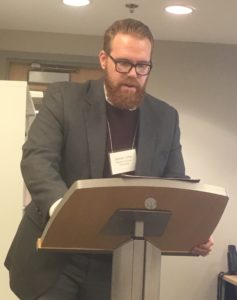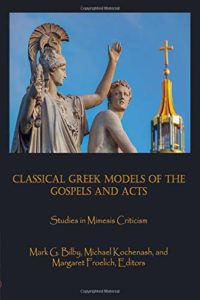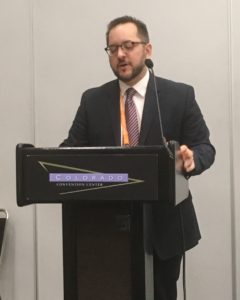2018 SBL Diary: Day Three
A busy day 3 began with a NASSCAL executive breakfast in our swanky hotel lounge (we had to smuggle a few of the exec. in; this is what happens when you give the hoi polloi something nice—we just take advantage). The NASSCAL board was about to change over after the Material of Christian Apocrypha conference in Charlottesville, so I gave my final update as President on the status of our various projects—including e-Clavis (with over 80 entries now completed) and the Early Christian Apocrypha series (the first two books are now in the hands of their new publisher: Wipf & Stock)—and we discussed possibilities for a second NASSCAL conference in Austin in 2020.

The first panel on my schedule for the day was the joint session of the Christian Apocrypha and Religious Competition in Late Antiquity sections. Jacob A. Lollar (Florida State University) started things off with “What Has Ephesus to Do with Edessa? The Syriac History of John, the Cult of the Dea Syria, and Religious Competition in Fourth-Century Syria.” The History of John has received little interest in scholarship, in part because of its (likely) language of composition (there still aren’t enough of us able to work in Syriac) and because it is considered secondary to the earlier Acts of John in Greek. Nevertheless, the text has some interesting qualities, not least is the fact that its story is told in Ephesus (and the author seems to know the city well) yet, Lollar believes, it was composed in fifth-/sixth-century Edessa. The “competition” of this text is with the cult of Artemis, though it seems to be standing in here for Edessa’s cult of Atargatis. Lollar sees the text as an attempt by post-Nicene Christians to establish orthodoxy in Edessa, combating not only the waning pagan worship of Atargatis but also rival Christians with different accounts of the life and mission of John. Lollar’s argument fits in well with views on the introduction of orthodoxy to Edessa held by Walter Bauer and Han Drijvers.
The following two papers looked at apocryphal tales of the activities of Peter. The first of these was by Jung Choi (North Carolina Wesleyan College): “Two Bodily Practices in the Acts of Peter.” My notes for this paper amount to one line and re-reading Choi’s abstract is no help in remembering what it was about. The problem may be that Choi based her analysis of the healing stories on Pierre Bourdiue’s game theory; I’m a meat-and-potatoes text critic, so structuralism is too rich for my constitution. Or my lack of attention could be the result of lingering effects from my indulgences of the night before. Or altitude sickness. Whatever the case, I was more attentive for the second of the two texts on Peter: “Magic and Polysemy: The Case of the Pseudo-Clementines” by Shaily Patel (Virginia Polytechnic Institute and State University). The Pseudo-Clementines engage in competition with a number of Christian groups, including followers of Marcion, Simon Magus, and, well, Paul. Patel focused her paper on magic, which she says is presented in the text as heresy. Put more clearly, it is not magic so much that is heretical as it is the Christian leaders who practice it. Yet even Peter performs some feats that could be called magical (healing, exorcisms), but Simon’s achievements are characterized much more frivolously (flight, necromancy, transformation of animals, invisibility)—precisely the kinds of activities found in magical papyri. Patel’s argument is fairly standard in the study of magic—our leader is a miracleworker, yours is a magician—and is prevalent in the apocryphal acts, particularly in the miracle contests of Peter and Simon. Patel remarked that “we should let texts retain their inconsistencies” and embrace the fact that the author/compiler of Ps-Clem. can disapprove of Simon’s magic but approve of Peter’s. Lily Vuong, in her response to the session, noted a similar inconsistency with Luke, who alters Mark to make Jesus look less “magical” yet does not resist attributing “magical” abilities to the apostles in Acts. An ancient Christian can practice magic, she said, and hate it too.
The final paper of the session was by Chris Frilingos (Michigan State University): “Blood into Stone: Violence, Sanctuary, and ‘Jewish Christianity’ in the Protevangelium Jacobi.” Frilingos’s abstract promised to cover a lot of ground, but his presentation was somewhat more narrowed to an examination of the “murder mystery” of Zechariah, the father of John the Baptist, that comes at the end of the Protevangelium of James. Here the soldiers of Herod, searching for the infant messiah, ask Zechariah “Where have you hidden your son?” Zechariah responds with, “I am a minister of God and attend continually upon his Temple. How should I know where my son is?” Zechariah is killed for his impunity, but his body vanishes, leaving behind only a pool of blood. Zechariah is regarded in Christian tradition as a martyr who died for the faith, but Frilingos demonstrated that the priest does none of the things expected of a martyr: he does not confess to being a Christian (indeed, he could not be) and does not die in some spectacular manner (burned at the stake, thrown into a pit of seals, etc.). Zechariah dies for the love of his son, which sounds really nice, but Frilingos pushed readers to delve further into what is going on in this episode, because Zechariah apparently does not know where his son is; would he have told the guards if he did? In the discussion period, I remarked that it is common for early Christian figures to be called “martyrs” even if they do not die for the faith; Cornelius, for example, is called a martyr in the Acts of Cornelius even though he dies peacefully. In such cases, we should understand “martyr” in its literal sense of “witness.” Mind you, I don’t think Christians have historically been all that fussy about these distinctions.
 After lunch I sat in on a Westar Institute session created by Mark Bilby (California State University) and Michael Kochenash (Hunan University) entitled “Mimesis Criticism: The Gospels and Greek Literature. The two are editors/contributors (with Margaret Froelich) of the recently-published Classical Greek Models of the Gospels and Acts: Studies in Mimesis Criticism (Claremont Press, 2018). The session was designed as an experimental approach to Dennis R. MacDonald’s work on mimesis—i.e., parallels between early Christian texts and Greco-Roman literature. My colleagues in Christian Apocrypha Studies and I have affection for MacDonald and support his arguments, at least to some extent—that Christians writing in Greek would evoke Greek literature is a no-brainer, but sometimes MacDonald’s examples seem a bit of a stretch. Bilby and Kochenash wanted to see if some movement could be made to convince scholars about MacDonald’s theories using the Jesus Seminar’s method of assembling interested scholars and having them vote on the evidence. The two convenors worked through an example, tabulated the votes, and then asked for feedback about the efficacy of the method. When asked, I sheepishly said that the process should start with a vote on the story on the whole, since examples of mimesis are more convincing on the structural level, and then vote on the individual elements. For more on this project, see Bilby’s blog Voces Anticae.
After lunch I sat in on a Westar Institute session created by Mark Bilby (California State University) and Michael Kochenash (Hunan University) entitled “Mimesis Criticism: The Gospels and Greek Literature. The two are editors/contributors (with Margaret Froelich) of the recently-published Classical Greek Models of the Gospels and Acts: Studies in Mimesis Criticism (Claremont Press, 2018). The session was designed as an experimental approach to Dennis R. MacDonald’s work on mimesis—i.e., parallels between early Christian texts and Greco-Roman literature. My colleagues in Christian Apocrypha Studies and I have affection for MacDonald and support his arguments, at least to some extent—that Christians writing in Greek would evoke Greek literature is a no-brainer, but sometimes MacDonald’s examples seem a bit of a stretch. Bilby and Kochenash wanted to see if some movement could be made to convince scholars about MacDonald’s theories using the Jesus Seminar’s method of assembling interested scholars and having them vote on the evidence. The two convenors worked through an example, tabulated the votes, and then asked for feedback about the efficacy of the method. When asked, I sheepishly said that the process should start with a vote on the story on the whole, since examples of mimesis are more convincing on the structural level, and then vote on the individual elements. For more on this project, see Bilby’s blog Voces Anticae.
The final panel of the day for me was, once again, Christian Apocrypha, this time with five papers grouped according to the theme of “Sex and Violence.” Catherine Playoust (University of Divinity) began with “‘And Still He Won’t Leave Me Alone’ (Acts Thom. 43.11): A Toxic Masculine Demon in the Acts of Thomas.” Playoust opened her paper with acknowledgement of the Me Too movement and said it could affect how we look at our texts, bringing attention to aspects that may have been glossed over in previous scholarship. In the story from the Acts of Thomas, a woman has been tormented by a demon for five years; her experience evokes domestic abuse (the demon rapes her at night, but she escapes during the day). The demon’s defense to Thomas also sounds like the words of an abuser (he professes his love for her and seeks pity for being cast away by the apostle). Playoust briefly alluded to a similar reading of the story of Mygdonia, who after being converted by Thomas, refuses to sleep with her husband, Charisius. The spurned husband’s attempts to convince Mygdonia to stay with him include statements that he chose her even though he could have been with women who were more beautiful. Michael Whitenton (Baylor University) followed Playoust with “Subversive (E)masculation: A Medical Perspective on Paul’s Baldness in Acts of Thecla.” Whitenton examined the description of Paul from Acts of Paul 3: “a man small of stature, with a bald head and crooked legs.” In antiquity, Whitenton argued, baldness was associated with virility; essentially it resulted from a low level of semen, either as a result of a medical condition or from promiscuity—neither of which would be considered virtuous to ancient readers. The women in the text, however, may have seen Paul’s baldness as an indication that he was “safe” to be around. The description of Paul is usually considered to be an attempt by the writer to make a connection between Paul and Socrates, who is described similarly in ancient sources. Whitenton mentioned this view when pressed about it in the discussion period but does not seem to have considered it important.

Andrew R. Guffey (McCormick Theological Seminary) turned our attention back to Thomas traditions in “Toxic Femininity? Enkrateia and Gender in Christian Apocryphal Literature.” The paper was a sequel of sorts to Guffey’s article “Motivations for Encratite Practices in Early Christian Literature” (JTS 65 [2014]: 515-49). He noted how women are portrayed in the social world of the texts as toxic if they interrupt male hegemony and if they lack self-control. Jennifer Hunter (Northern Arizona University) covered similar territory in “Perfection and the Ritual Reunification of Male and Female in the Gospel of Philip.” She examined Gospel of Thomas 114, where Peter opposes Jesus in allowing Mary to be included in their company. Jesus corrects Peter with “friendly assurance,” but Hunter said she wanted Mark’s Jesus to show up and rebuke him. Hunter then juxtaposed the desire for unification of male and female in Gos. Thom., which provides no ritual means for doing so, with the Gospel of Philip’s description of the bridal chamber, a ritual intended to reverse the myth of separation that underlies Gos. Thom. That may well be so, but I’m left wondering where the theme of violence is found in the paper (that is, besides Peter’s conflict with Jesus over Mary).
And finally, Eric Vanden Eykel (Ferrum College) finished up the day with “Faithfulness or a Flamethrower? The Judgment and Redemption of Salome in the Protevangelium of James.” Vanden Eykel’s paper linked the episode of violence—the midwife’s intrusive examination of Mary and public declaration about the status of her hymen—with the judgment of God as described in Exodus. Mary is intertextually linked to the mountain of Moses’ epiphany, thus making Jesus the new law; the stillness at the birth of Jesus is reflected in the quiet that comes when God speaks the Torah. The cloud and fire in the cave are also indicative of the presence of God in Exodus; thus Jesus is equated with God in Prot. Jas. Coming back to Salome, Vanden Eykel noted that Exodus includes an instruction not to touch the mountain of the law. The first Christian Apocrypha Section session included Brad Rice’s paper arguing that the episode of the suspension of time was not original to Prot. Jas.; Vanden Eykel brought us full circle with further evidence for his own view that it is integral to understanding the text’s christology. The two will have to fight it out.
 They could begin at dinner. Brent Landau arranged for a number of the Christian Apocrypha Section committee members and other notables to dine in a nice Italian restaurant. And a few of us went on from there to the Wipf & Stock reception (with a stop at a dispensary along the way). I saw Stephen Shoemaker at the reception and proceeded to tell him that I could not understand how he could be a scholar and a believing Christian (Greek Orthodox) at the same time. This is an argument I have with a lot of scholars and I always regret it in retrospect because I just come off as an arrogant atheist. So Stephen called me an arrogant atheist and we agreed to disagree. At least this time I can blame my obtuseness on my snickerdoodle edible—and the altitude sickness. I retreated to the company of a group of Canadians in the back corner and spent the rest of the evening in their warm embrace.
They could begin at dinner. Brent Landau arranged for a number of the Christian Apocrypha Section committee members and other notables to dine in a nice Italian restaurant. And a few of us went on from there to the Wipf & Stock reception (with a stop at a dispensary along the way). I saw Stephen Shoemaker at the reception and proceeded to tell him that I could not understand how he could be a scholar and a believing Christian (Greek Orthodox) at the same time. This is an argument I have with a lot of scholars and I always regret it in retrospect because I just come off as an arrogant atheist. So Stephen called me an arrogant atheist and we agreed to disagree. At least this time I can blame my obtuseness on my snickerdoodle edible—and the altitude sickness. I retreated to the company of a group of Canadians in the back corner and spent the rest of the evening in their warm embrace.
My 2018 SBL experience came to an end on day 4 with an early morning taxi ride (5 am!) to the airport. As I opened the trunk to grab my bags, the driver started to drive away. I yelled, “Hey!” and he stopped and apologized. I think he was high.
